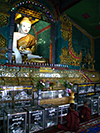|
Sutaungpyay Phaya (ဆုတောင်းပြည့်ဘုရား)

Burmese. ‘Pagoda
of the Fulfilled Wish’ or
‘Wish-granting Pagoda’. Name of a Buddhist
temple
on the summit of
Mandalay Hill
(fig.),
that was built in the 11th century AD by King
Anawrahta (fig.)
and towers above the city and the flat plain below.
The temple has a large terrace overlooking the Royal Palace, the Irrawaddy River
and the surrounding plains. The panoramic view attracts many visitors and in the
evening the place gets flocked with people who come to enjoy sunset. The temple
can be reached by a long staircase, which at the
foot of the hill is flanked by two giant
guardian lions or
chinthe (map -
fig.),
as well as by road. Somewhere halfway
up the hill there is a pavilion with a large gilded statue of the Revelation
Buddha (location
- fig.),
known in Burmese as
Byar Deik Paye Phaya.
This
standing
Buddha image performs a unique
mudra in which the
Buddha
is pointing his finger with an outstretched arm, a pose found only in Myanmar
and which refers to a local story in which the Buddha is said to point out the
land where a future kingdom
was to
be established. From this point it is a little
further uphill to the
base of the main complex from where one needs to continue barefoot, either by a stairway, an
escalator or an elevator. Ascending by stairs, just before reaching the
summit is a small
stupa
with a statue of the ogress
Sanda Muhki (fig.),
who is considered to be
an earlier incarnation of King
Mindon Min (fig.),
the founder of Mandalay. Also transliterated Su Taung Pyae Phaya and Su Taung Pyi Paya.
See also
Phaya and
MAP.
回






|

